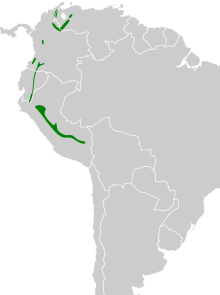| Wattled guan | |
|---|---|

| |
| Scientific classification | |
| Domain: | Eukaryota |
| Kingdom: | Animalia |
| Phylum: | Chordata |
| Class: | Aves |
| Order: | Galliformes |
| Family: | Cracidae |
| Genus: | Aburria Reichenbach, 1853 |
| Species: | A. aburri
|
| Binomial name | |
| Aburria aburri (Lesson, 1828)
| |

| |
The wattled guan (Aburria aburri) is a species of bird in the family Cracidae. It is a fairly large black cracid with blue-based, black-tipped beak and a long, red-and-yellow wattle.
It is found in Colombia, Ecuador, Peru, and Venezuela. Its natural habitats are subtropical or tropical moist lowland forest and subtropical or tropical moist montane forest. The wattled guan is a fairly shy species that is mostly seen when it perches on the outer edge of the canopy from a distance. Like many tropical forest birds, it is heard more often than seen. It is threatened by habitat destruction and the IUCN has assessed its conservation status as being "near threatened".[1]
YouTube Encyclopedic
-
1/1Views:380
-
Wattled Guan (Aburria aburri) calls @ PNN Tatamá, Colombia
Transcription
Description
The wattled guan is recognisable by the elongated red and yellow fleshy wattle that dangles from its throat. It is a large bird with a long tail, about 75 centimetres (30 in) long and weighing between 1,200 and 1,550 grams (42 and 55 oz). The plumage is black, the beak is blue and the feet are flesh-coloured.[2]
Distribution and habitat
The wattled guan is endemic to the foothills of the Andes in South America. Its range extends from northwestern Venezuela through Colombia, Ecuador and Bolivia to southern Peru. It used to be found on the western slopes of the Andes but this is believed no longer to be the case. On the eastern slopes it is rare in Venezuela but slightly more common in Colombia. Its natural habitat is wet mountain forest and woodland verges, and it also occurs in secondary forest. Its altitudinal range is 500 to 2,500 metres (1,600 to 8,200 ft).[1]
References
- ^ a b c BirdLife International (2016). "Aburria aburri". IUCN Red List of Threatened Species. 2016: e.T22678440A92773628. doi:10.2305/IUCN.UK.2016-3.RLTS.T22678440A92773628.en. Retrieved 12 November 2021.
- ^ "Wattled guan (Aburria aburri)". Wildscreen Arkive. Archived from the original on 2015-09-06. Retrieved 2015-08-07.
- AGUILAR Héctor F. & Rafael F. AGUILAR H., 2012.- Redescripción del Gualí Aburria aburri (Lesson, 1828), (Craciformes: Cracidae) con notas sobre el nido y el huevo Rev. Ecol. Lat. Am. 17(3): 53-61 ISSN 1012-2494 www.cires.org.ve
External links
 Media related to Aburria aburri at Wikimedia Commons
Media related to Aburria aburri at Wikimedia Commons Data related to Aburria aburri at Wikispecies
Data related to Aburria aburri at Wikispecies





